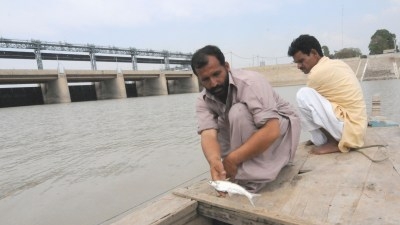Refurbishment brings new life
Before construction and repairs could begin, about 160 fishing families, including Hussain, his wife, and two daughters, had to move. The families were living in two squatters’ communities on either side of the river next to the old barrage. At the time, many protested, because they feared losing a way of life they had become accustomed to.
“Initially, we were very worried. It was a real crisis for us and many families were upset,” recalls Hussain, 36, who lived on the left bank in a crude clay hut.
But their concerns were eventually laid to rest when the government resettled Hussain, his seven brothers, their families, and neighbors in newly built brick homes just 500 meters inland from the river. They were equipped with toilets, electricity, kitchen areas, and other features that most had never experienced before.
The community also received two new schools, two mosques, and a medical center. Many people were employed as laborers or security workers during construction. Families were given financial compensation for their resettlement that most used to buy new fishing boats.
“It was like winning a big prize for us,” Hussain says now. “We feel very lucky to have this new place, this new life.”
At his father’s side, Hussain’s son, Niaz, 8, continues the family fishing tradition but also attends school with his seven siblings. Niaz loves to be on the river where he sometimes catches a giant devil catfish or sees rare Indus dolphins, and during winter, thousands of birds from Siberia and elsewhere migrate to an island sanctuary preserved during the barrage rehabilitation project.
“This is a beautiful and special place to be with my family,” says Niaz. His newly married sister, Asma, 18, agrees, saying their ongoing proximity to numerous aunts and female cousins allows her to remain in a joint family, that does elaborate quilting and traditional basket weaving from river reeds.
Their change in fortune came just in time, says Hussain’s mother, Izzat Bibi, 65. Not long after the barrage’s rehabilitation came the severe floods of 2010. While the renovated barrage stood firm, thousands of acres of surrounding land were inundated by smaller channels that couldn’t handle the flow. But Bibi’s new brick home wasn’t touched.
“Without this work being done, maybe we would have been swept away from our old houses. We would only be fish food somewhere in the water now, with all the family destroyed,” she says.
Fellow fisherman and neighbor Mahboob Ahmed, 35, agrees. “Here we are much better than before, where we lived in danger on the river,” says Ahmed. “Without this help, we would now be even poorer, or maybe dead.”
Other challenges remain
All is not perfect, however. Experts at the barrage, like sub-divisional officer Faisal Mushtaq, say the repaired barrage can now withstand severe water pressure, but research indicates outlying canals could still flood if water levels rise rapidly again.
“The flood season is approaching, and we may have to face these terrible problems once more,” says Mushtaq.
At the community health center built for the barrage project, much of the electronic medical equipment now lies disused and broken since floodwaters climbed almost two meters here in 2010. The government health department responsible for its refurbishment hasn’t supplied the funds, says the center’s doctor, Mohammed Shehran.
Still, Razia Bibi, visiting the clinic with her baby daughter, Aliza, appreciates that doctors and nurses work at the health center around the clock for emergencies and baby deliveries.
“I am walking six kilometers to see that my baby is checked regularly,” explains Razia. “Before, our people would have to go more than 20 km to get medical help. This big wall in the water has made our lives much easier.”

